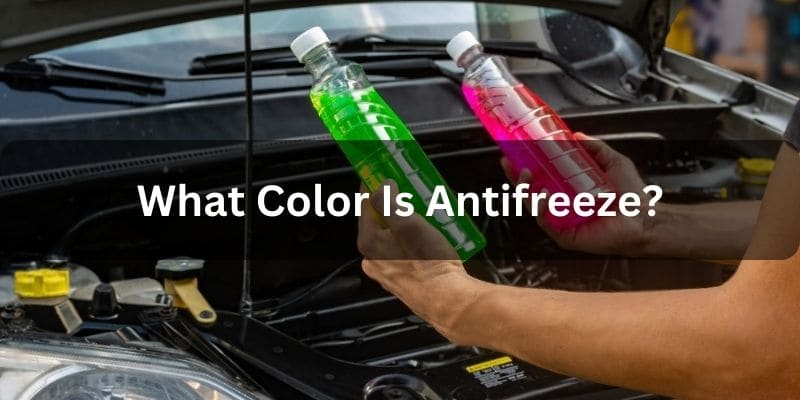Antifreeze, also known as engine coolant, comes in a variety of colors, and choosing the right type for your vehicle is important. The color of the coolant can indicate different chemical formulations with varying properties that impact performance and component protection.
This article will explore what color is antifreeze does coolant color matters and what does the coolant colors actually mean. Additionally, you will learn the type of coolant to use in your car engine.
What is Antifreeze/Engine Coolant?
Antifreeze, or engine coolant, is a liquid that circulates through the engine to absorb heat and prevent overheating. It also prevents corrosion of metal components and helps keep the engine at optimal operating temperatures.
The main ingredient is usually ethylene glycol which lowers the freezing point so coolant won’t freeze in cold weather. Other additives are used to raise the boiling point, inhibit rust, and prevent scale deposits.
What Are The Different Coolant Colors?
There are a few common antifreeze colors. Here are the coolant color meanings of each one:
Green
This is a traditional ethylene glycol coolant with silicate corrosion inhibitors. It has been used for decades and is still common in older vehicles.
Orange
Indicates a newer extended-life organic acid technology (OAT) coolant. It contains organic acids for corrosion protection.
Red/Pink
Also an OAT coolant but is often dyed red for certain makes or models. May also indicate hybrid OAT (HOAT).
Blue
Used by some manufacturers but also indicates pre-mixed or ready-to-use coolant.
Yellow
Used by some luxury makes and can indicate higher silicate content.
Purple
Uncommon, but may indicate hybrid organic acid technology (HOAT) coolant.
Why Does Antifreeze Come in Different Colors?
The different colors of coolant are primarily used to distinguish coolant types for proper mixing and maintenance. Using the wrong coolant or mixing incompatible types can lead to impaired protection and engine damage.
Color coding helps avoid this. Manufacturers also use specific colors for certain models to aid in identification. The dye does not affect the chemical properties.
Types of Coolant color
Here’s a table detailing different types of coolant, their inhibitors, the types of vehicles they are commonly used in, and their respective colors:
| Type of Coolant | Inhibitors | Vehicle Types | Coolant Color |
| IAT (Inorganic Additive Technology | Inorganic additives (phosphate and borate) | Older vehicles, Some industrial and agricultural equipment | Typically Green |
| Organic Acid Technology | Organic acids (OA), Neutralizing amines | Certain newer vehicle models, Developed to be aluminum-friendly | Orange or Yellow |
| Hybrid Organic Acid Technology | Hybrid inhibitors (silicate and organic) | Hybrid and electric vehicles, Some newer passenger cars | Various (often pink, orange, or purple) |
| Ethylene Glycol | Corrosion inhibitors, Anti-foaming agents | Most passenger vehicles | Green or Orange |
| Propylene Glycol | Corrosion inhibitors, Anti-foaming agents | Solar water heating systems, Some food and beverage applications | Pink or Red |
What is Organic Acid Technology (OAT) Coolant?
OAT coolants use organic acid corrosion inhibitors instead of traditional inorganic additives like silicates. They offer longer service life, typically 5 years or 150,000 miles before needing coolant replacement.
OAT coolants are typically dyed orange, red, or purple. They cannot be mixed with traditional green coolant.
What About Hybrid Organic Acid Technology (HOAT) Coolants?
As the name implies, HOAT coolants use a combination of OAT and traditional inorganic corrosion inhibitors.
This allows a service life of 5 years/150,000 miles while enabling compatibility with a wider range of coolant types. HOAT coolants are usually dyed red or maybe purple.
Is One Type of Antifreeze Better Than Another?
For most modern vehicles, OAT or HOAT coolants offer the best performance and protection. They are free of silicates which can cause buildup in some engines.
Check your owner’s manual as some vehicles still require traditional green coolant. Make sure to use the specific coolant recommended by your manufacturer.
Does Color Indicate Coolant Quality?
The color itself does not necessarily indicate better or worse quality. However, OAT and HOAT coolants are considered newer technologies offering improved longevity versus traditional green coolants.
But there can be variation in quality within each coolant type, so always go with a reputable brand.
Is It Okay to Mix Different Color Coolants?
Mixing coolants of different colors/chemistries such as green and orange is generally not recommended. In some cases, it may work, but for optimal results use just one type of coolant. Pre-mixed or “universal” coolants are designed to be compatible with multiple formulations.
How Often Should You Change Your Antifreeze?
Follow your vehicle manufacturer’s coolant replacement interval, typically every 2-5 years or 30,000-150,000 miles.
You should also periodically check levels and conditions regardless of age/mileage. Test kits are available to check freeze points and corrosion protection.
Can You Use Plain Water as Engine Coolant?
Water by itself is not recommended as it provides no anticorrosion, raises the freezing point, and promotes mineral buildup.
Pre-mixed antifreeze or a proper distilled water/concentrate mix should be used. Never use just tap water, which contains minerals.
Key Takeaways on Antifreeze Colors
- The color indicates different coolant technologies – green, orange, red, etc.
- OAT and HOAT are newer, extended-life coolants offering the best protection.
- Don’t mix incompatible coolants. Use what your vehicle manufacturer specifies.
- Quality depends on the formula, not the color. Stick with a major brand.
- Check your coolant condition and levels regularly for optimal performance.
- Adding up coolant regularly is vital maintenance for protecting your engine.
What color is all vehicle antifreeze?
There is no single color of antifreeze used for all vehicles. Different vehicle manufacturers may recommend using antifreeze of specific colors depending on the type of coolant formulated for optimal protection and performance in their engines.
The two main types of engine coolants are ethylene glycol-based and propylene glycol-based formulations.
- Green antifreeze usually contains older inorganic additive technology (IAT) suitable for some older vehicles but not recommended for use in most modern cars.
- Yellow and orange antifreeze formulations usually contain hybrid organic acid technology (HOAT), making them a universally compatible option for a wide range of vehicles.
- Red antifreeze commonly uses advanced organic acid technology (OAT) important for newer vehicles with aluminum or plastic components requiring maximum corrosion defenses.
What happens if you use the wrong color antifreeze?
If an incompatible coolant type is used, its additives may not adequately prevent corrosion of all metals inside the radiator, water pump, and engine block. This can lead to premature rusting and deterioration over time.
Mixing coolant colors without properly flushing the system first is especially dangerous, as different additive residues can negatively interact and reduce one another’s effectiveness. This lack of protection may cause corrosion issues down the road.
The wrong coolant could also have an inadequate freeze point that fails to prevent freezing in very cold weather. An improper glycol concentration from using an incompatible product risks engine overheating from inadequate cooling ability.
Is antifreeze red or green?
Coolants are of both red and green colors. The color of coolants has no impact on the quality of the coolant.
Traditionally, older antifreeze formulations were usually green in color. This “green” antifreeze contained inorganic additive technology (IAT) like silicates and phosphates to prevent corrosion.
While the modern car coolants are often red. This “red” antifreeze contains organic acid technology (OAT) additives like carboxylic and benzoic acids that provide better protection against corrosion compared to green IAT for modern engines.
Should I use red or green coolant?
It depends on your vehicle. Red is best for most newer cars, while green coolant are often used in old cars. However, check your owner’s manual – it will specify the exact coolant type and color required.
Conclusion
Antifreeze comes in various colors depending on its formulation. Modern vehicles often require red, yellow, or orange coolants containing improved OAT or HOAT technologies.
These advanced formulas provide better corrosion protection for today’s complex engine materials like aluminum and plastic.
However, the best advisor is always your owner’s manual – it specifies the ideal coolant type for your specific car engine make and model.
Following the recommended color and changing it as scheduled ensures your cooling system stays in top condition.
Proper coolant selection and maintenance are key to preventing freezing or overheating issues down the road.

Hi, Michael Williams here. I have always loved everything with an engine. After earning my degree in automotive engineering, I spent 5 years testing vehicles for a major manufacturer in Illinois. Now I am using my technical skills to review the latest models online and help others troubleshoot their engine problems with effective solutions.
